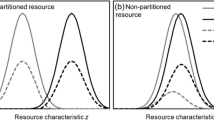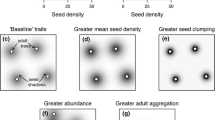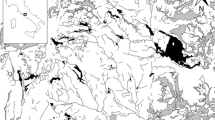Abstract
Outcomes of interspecific competition, and especially the possibility of coexistence, have been extensively studied in theoretical ecology because of their implications in community assemblages. During the last decades, the influence of different time scales through the local/regional dynamics of animal communities has received an increasing attention. Nevertheless, different time scales involved in interspecific competition can result form other processes than spatial dynamics. Here, we envision and analyze a new theoretical framework that couples a game theory approach for competition with a demographic model. We take advantage of these two time scales to derive a reduced model governing the total densities of the two populations and we study how these two time scales interfere and influence outcomes of species competition. We find that a competition process occurring on a faster time scale than demography yields a “priority effect” where the first species introduced outcompetes the other one. We then confirm previous findings stipulating that species coexistence is favored by large difference in time scales because the extinction/recolonization process. Our results then highlight that an integration of demographic and competition time scales at both local and regional levels is mandatory to explain communities assemblages and should become a research priority.





Similar content being viewed by others
References
Alexander JM (2003) The Stanford encyclopedia of philosophy, chapter evolutionary game theory. Stanford University Press, Palo Alto
Almany GR (2003) Priority effects in coral reef fish communities. Ecology 84:1920–1935
Auger P, Poggiale JC (1996) Emergence of population growth models: fast migration and slow growth. J Theor Biol 182:99–108
Auger P, Bravo de la Parra R (1998) Hawk-dove games and competition dynamics. Math Comput Modell 27:89–98
Auger P, Bravo de la Parra R, Poggicale JC, Sanchez E, Nguyen Huu T (2008) Structured population models in biology and epidemiology, lecture notes in mathematics, vol. 1936, Mathematical Biosciences Subseries, chapter Aggregation of variables and applications to population dynamics, pp 209–263Springer, Berlin
Auger P, Bravo de la Parra R, Sanchez E (2001) Behavioral dynamics of two interacting hawk-dove populations. Math Models Methods Appl Sci (M3AS) 11:645–661
Auger P, Bravo de la Parra R (2002) A predator-prey model with predators using hawk and dove tactics. Math Biosci 2002:185–200
Auger P, Kooi B, Bravo de la Parra R, Poggiale JC (2006) Bifurcation analysis of a predator prey model with predators using hawk and dove tactics. J Theor Biol 238:597–607
Auger P, Pontier D (1998) Fast game theory coupled to slow population dynamics: the case of domestic cat populations. Math Biosci 148:65–82
Auger P, Roussarie R (1994) Complex ecological models with simple dynamics: from individuals to populations. Acta Biotheor 42:111–136
Cody ML, Diamond JM (1975) Ecology and evolution of communities. In: Cody M L, Diamond JM (eds) Harvard University Press, Cambridge
Cressman R, Dash AT, Akin E (1986) Evolutionary games and two species population dynamics. J Math Biol 23:221–230
Cressman R (1992) The stability concept of evolutionary game theory, lecture notes in biomathematics, vol 94. Springer, Berlin
Cressman R (1995) Evolutionary game theory with two groups of individuals. Games Econ Behav 11:237–253
Christophe L, Auger P, Gaillard JM (2004) Continuous cycling of grouped vs. solitary strategy frequencies in a predatorprey model. Theor Popul Biol 65:263–270
Enquist BJ, Brown JH, West GB (1998) Allometric scaling of plant energetics and population density. Nature 395:163–165
Hanski I (1983) Coexistence of competitors in patchy environment. Ecology 64:493–500
Hanski I, Gilpin ME (1997) Metapopulation biology: ecology genetics and evolution. Academic Press, London
Hofbauer J, Sigmund K (1998) Evolutionary games and population dynamics. Cambridge Univeristy Press, Cambridge
Hugueny B, Cornell HV, Harrison S (2007) Metacommunity models predict the local-regional species richness relationship in a natural system. Ecology 88:1696–1706
Iwasa Y, Endreasen V, Levin SA (1989) Aggregation in model ecosystems ii. Approximate aggregation. IMA J Math Appl Med Biol 6:1–23
Keeling MJ (2000) Simple stochastic models and their power-law type behaviour. Theor Popul Biol 58:21–31
Koleff P, Gaston KJ (2002) The relationships between local and regional species richness and spatial turnover. Glob Ecol Biogeogr 11:363–375
Lawler SP, Morin PJ (1993) Temporal overlap, competition and priority effect. Ecology 74:174–182
Levin SA (1969) Dispersion and population interactions. Am Nat 108:207–228
Marvà M, Moussaoui A, Auger P (2013) A density-dependent model describing age-structured population dynamics using hawk-dove tactics. J Differ Equ Appl 19:1022–1034
Maynard Smith J, Price GR (1973) The logic of animal conflicts. Nature 246:15–18
Maynard-Smith J (1982) Evolution and the theory of games. Cambridge University Press, Cambridge
Mchich R, Auger P, Lett C (2006) Effects of aggregative and solitary individual behaviors on the dynamics of predator-prey game models. Ecol Model 197:281–289
Mouquet N, Munguia P, Keintel JM, Miller TE (2003) Community assembly time and the relationship between local and regional species richness. Oikos 103:618–626
Murray JD (1989) Mathematical biology. Springer, Berlin
Ricklefs RE (1987) Community diversity: relative roles of local and regional processes. Science 235:167–171
Shorrocks B, Bingley M (1994) Priority effects and species coexistence: experiments with fungal breeding drosophila. J Anim Ecol 63:799–806
Sanchez E, Auger P, Bravo de la Parra R (1997) Influence of individual aggressiveness on the dynamics of competitive populations. Acta Biotheor 45:321–333
Shurin JB, Allen EG (2001) Effects of competition, predation, and dispersal on species richness at local and regional scales. Am Nat 158:624–637
Sigmund K (1986) A survey of replicator equations. In: Casti JL, Karlqvist A (eds) Complexity, language and life: mathematical approaches. Springer, Berlin, p 16
Slatkin M (1974) Competition and regional coexistence. Ecology 55:128–134
Vandermeer J, Evans MA, Foster P, Hk T, Reiskind M, Wund M (2002) Increased competition may promote species coexistence. Proc Natl Acad Sci U S A 99:8731–8736
Acknowledgments
This work was partially supported by the Franco-Algerian project: Tassili 10MDU800 and the National Research Project: PNR 08/U13/1030. The authors are grateful to the anonymous reviewers for their valuable suggestions.
Author information
Authors and Affiliations
Corresponding author
Appendices
Appendix 1: Fast-Time System
We supply a quick analysis of the fast system in Eq. (11). System (11) is a set of two coupled ordinary differential equations. Our variables \(y_{1}\) and \(y_{2}\) lying in \([0,1]\). The biologically-relevant dynamics takes place within the square unit \([0,1]\times [0,1]\). The steady states are located at its corners \((0,0),(0,1),(1,0),(1,1)\), and another equilibrium, \(\left( \frac{G_{2}}{C_{21}},\frac{G_{1}}{C_{12} }\right) \) inside the domain if \(G_{2}<C_{21}\) and \(G_{1}<C_{12}.\)
To obtain the local stability results, we write the Jacobian matrix associated to system (11):
-
In the case of the origin the Jacobian matrix reads:
$$ J(0,0)=\left( \begin{array}{ll} \frac{G_{1}}{2} &{} 0\\ 0 &{} \frac{G_{2}}{2} \end{array}\right) . $$The two eigenvalues are positive and the origin is an unstable node.
-
In the case of the \((1,0)\) the Jacobian matrix reads:
$$J(1,0)=\left( \begin{array}{ll} -\frac{G_{1}}{2} &{} 0\\ 0 &{} \frac{1}{2}\left( G_{2}-C_{21}\right) \end{array}\right) . $$Thus, \((1,0)\) is a stable node if both entries on the main diagonal are negative which can be expressed by \(G_{2}<C_{21}.\)
-
In the case of the \((0,1)\) the Jacobian matrix reads:
$$ J(1,0)=\left( \begin{array}{ll} \frac{1}{2}\left( G_{1}-C_{12}\right) &{} 0\\ 0 &{} -\frac{G_{2}}{2} \end{array}\right) $$Thus, \((0,1)\) is a stable node if \(G_{1}<C_{12}.\)
-
Concerning the Jacobian matrix of \((1,1)\):
$$J(1,1)=\left( \begin{array}{ll} -\frac{1}{2}\left( G_{1}-C_{12}\right) &{} 0\\ 0 &{} -\frac{1}{2}\left( G_{2}-C_{21}\right) \end{array}\right) .$$Its eigenvalues are negative which if \(G_{1}>C_{12}\) and \(G_{2}>C_{21}.\)
-
The last stationary state reads \(\left( \frac{G_{2}}{C_{21}} ,\frac{G_{1}}{C_{12}}\right) \), after some algebra, the Jacobian matrix reads:
$$J\left( \frac{G_{2}}{C_{21}},\frac{G_{1}}{C_{12}}\right) =\left( \begin{array}{ll} 0 &{} -\frac{1}{2}C_{12}\frac{G_{2}}{C_{21}}\left( 1-\frac{G_{2}}{C_{21} }\right) \\ -\frac{1}{2}C_{21}\frac{G_{1}}{C_{12}}\left( 1-\frac{G_{1}}{C_{12}}\right) &{} 0 \end{array}\right) $$The equilibrium point \(\left( \frac{G_{2}}{C_{21}},\frac{G_{1}}{C_{12} }\right) \) must be located inside the unit square to make sense, i.e. \(G_{1}<C_{12},\)and \(G_{2}<C_{21},\)thus, this equilibrium is saddle.
Appendix 2: Slow-Time System
We sketch the analysis of the defined system (17), (18) and (19).
1.1 Equilibria and Local Stability Analysis of Model 17: The Case When Species 1 is Pure Hawk
There are four feasible equilibria. \((0,0)\), \((1,0)\), \((0,1)\) and \((1,1-b)\) The feasibility conditions for the last equilibrium require that \(b<1\). We can analyze the stability of equilibrium point by the following Jacobian matrix
-
The Jacobian matrix \(J(0,0)\) is a diagonal matrix; its eigenvalues are \(r_{1}\) and \(r_{2}\). This implies the equilibrium \(\left( 0,0\right) \) is unstable.
-
The Jacobian matrix \(J(1,0)\) is a diagonal matrix. This matrix has two eigenvalues: one is negative number \(\lambda _{1}=-r_{1}<0\) and another eigenvalue \(\lambda _{2}=r_{2}(1-b).\) Thus the equilibrium \(\left( 1,0\right) \) is stable if \(b>1.\)
-
The Jacobian matrix \(J(0,1)\) is a lower triangular matrix; its eigenvalues are \(\lambda _{1}=r_{1}\) and \(\lambda _{2}=-r_{2}\) Thus,\(\left( 0,1\right) \) is saddle.
-
The last stationary state reads \((1,1-b)\), After some algebra one gets that as soon as the Jacobian matrix \(J(1,1-b)\) is an lower triangular matrix; its two eigenvalues are \(\lambda _{1}=-r_{1}\) and \(\lambda _{2}=-r_{2}(1-b)\). This implies the equilibrium \(\left( 1,1-b\right) \) if it exists, is stable.
1.2 Equilibria and Local Stability Analysis of Model 18: The Case When Species 2 is Pure Hawk
A similar analysis yields the local stability of the stationary state of system (18), We can write the Jacobian matrix as following:
-
For the first equilibrium \((0,0)\) we find \(\lambda _{1}=r_{1}\) and \(\lambda _{2}=r_{2}\). Thus the equilibrium \((0,0)\) is unstable.
-
For \((1,0)\) one gets again two eigenvalues, \(\lambda _{1}=-r_{1}\) and \(\lambda _{2}=r_{2}.\) Thus \(\left( 1,0\right) \) is saddle point.
-
For \((0,1)\) the first eigenvalue is \(\lambda _{2}=-r_{2}\). The other eigenvalue is \(\lambda _{1}=r_{1}(1-a)\). Thus if \(a>1\), the equilibrium is stable, else it is saddle.
-
In the remaining case of the equilibrium point \((1-a,1)\). (the condition for its existence is that \(a<1\)) after some algebra, one gets that as soon as the Jacobian matrix \(J(1-a,1)\) is an upper triangular matrix; its eigenvalues are \(\lambda _{1}=-r_{1}(1-a)\) and \(\lambda _{2}=-r_{2}\) yielding local stability of \((1-a,1)\) as soon as \(a<1\) hold.
1.3 Equilibria and Local Stability Analysis of Model 19: The Case of All Aggressive Individuals
-
The Jacobian matrix of (19) computed at \((0,0)\) is given by
$$ J\left( 0,0\right) =\left( \begin{array}{ll} r_{1} &{} 0\\ 0 &{} r_{2} \end{array}\right)$$For any value of the parameters the origin is unstable.
-
The Jacobian matrix of (19) computed at \((1,0)\) is given by
$$ J\left( {1,0} \right) = \left( {\begin{array}{*{20}l} { - r_{1} } \hfill & { - ar_{1} } \hfill \\ 0 \hfill & {r_{2} (1 - b)} \hfill \\ \end{array} } \right) $$Thus, the equilibrium \((1,0)\) is stable if \(b>1\) otherwise, it is saddle node.
-
The Jacobian matrix of (19) computed at \((0,1)\) is given by
$$ J\left( {0,1} \right) = \left( {\begin{array}{*{20}l} {r_{1} \left( {1 - a} \right)} \hfill & 0 \hfill \\ { - r_{2} b} \hfill & { - r_{2} } \hfill \\ \end{array} } \right) $$This Jacobian matrix has two eigenvalues: \(-r_{2}\) and \(r_{1}\left( 1-a\right) \). Thus if \(a>1\), the equilibrium is stable, else it is saddle.
-
For the last equilibrium \((u^{*},v^{*})\). The Jacobian matrix \(J\left( u^{*},v^{*}\right) \) becomes:
$$ J\left( u^{*},v^{*}\right) =\left( \begin{array}{ll} -r_{1}u^{*} &{} -ar_{1}u^{*}\\ -r_{2}bv^{*} &{} -r_{2}v^{*} \end{array}\right) $$Since, the trace of this previous 2-dimensional matrix is negative. To be a sink, its determinant must be positive leading to the condition \(ab<1.\) otherwise, it is saddle.
Rights and permissions
About this article
Cite this article
Moussaoui, A., Auger, P. & Roche, B. Effect of Hawk-Dove Game on the Dynamics of Two Competing Species. Acta Biotheor 62, 385–404 (2014). https://doi.org/10.1007/s10441-014-9224-x
Received:
Accepted:
Published:
Issue Date:
DOI: https://doi.org/10.1007/s10441-014-9224-x




